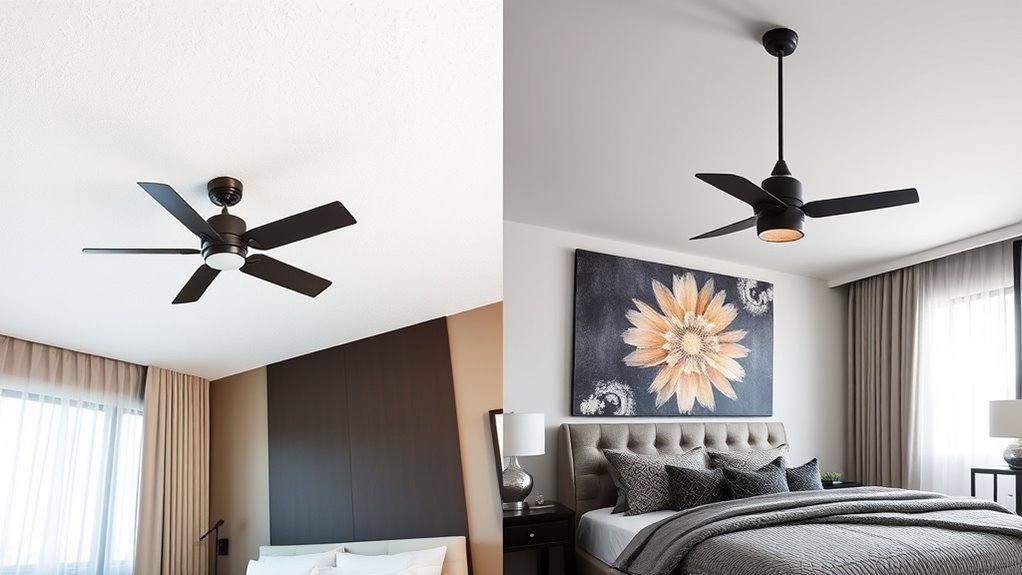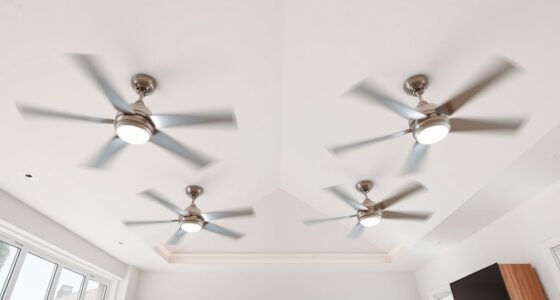Choosing between flush-mount and downrod ceiling fans depends on your room’s height, style, and airflow needs. If your ceiling is 8 feet or lower, a flush-mount fan keeps safety and style in check. For taller ceilings, a downrod fan provides better air circulation and design options. Understanding these factors guarantees you select the right fit for comfort and safety. Keep exploring to find out more about making the best choice for your space.
Key Takeaways
- Use flush-mount fans for low ceilings (8 ft or less) to ensure safety and minimize headroom obstruction.
- Choose downrod fans for high ceilings (9 ft or more) to improve airflow distribution and lighting coverage.
- Consider room style: modern spaces favor flush-mount, while traditional interiors suit downrod fans.
- Prioritize safety and clearance: flush mounts reduce hazards in low-ceiling rooms, downrods prevent fan hang-low in tall spaces.
- Factor in installation complexity and budget: flush-mount fans are easier and less costly to install, while downrod fans offer enhanced ventilation benefits.
Understanding Flush-Mount and Downrod Mountings

When choosing a ceiling fan, understanding the difference between flush-mount and downrod mountings is essential. Flush-mount fans sit directly against the ceiling, making them ideal for rooms with low ceilings. They often offer versatile lighting options, allowing you to select fixtures that blend seamlessly with your decor. The mounting style also impacts energy efficiency; flush-mount fans may be less effective at circulating air in large rooms, while downrod fans can provide better coverage. Consider your room’s height and lighting needs to determine which mounting style enhances both functionality and style. The design style of the fan can influence the overall aesthetic, whether you prefer a rustic farmhouse look or a modern minimalist vibe. Additionally, selecting the appropriate mounting can improve airflow efficiency, making your space more comfortable and energy-efficient. Proper installation height can also affect noise levels and safety, especially in rooms with high traffic or children.
Ideal Room Heights for Each Installation Style

Choosing the right fan style depends heavily on your room height. Flush-mount fans work best in low ceilings or standard heights, while downrod models suit taller spaces. Understanding these differences helps guarantee your fan fits perfectly and functions efficiently. Additionally, selecting the appropriate installation can influence energy efficiency and overall comfort in your room fan installation styles. Proper installation also ensures safety and longevity of the fan, which can be impacted by the ceiling height and mounting method used. Properly installed fans can also improve airflow and reduce energy costs, especially in spaces with specific room dimensions.
Low Ceiling Compatibility
If your room has a low ceiling, selecting the right fan installation can make a significant difference in both safety and style. Flush-mount fans are ideal, as they sit close to the ceiling, reducing the risk of head bumps and maintaining a sleek look. They work best with smaller ceiling fan sizes and limited lighting options, offering a clean aesthetic. Downrod fans, on the other hand, require more ceiling height to avoid hanging too low, which can be unsafe and obtrusive. Here’s a quick comparison:
| Feature | Flush-Mount | Downrod |
|---|---|---|
| Ceiling Height | 8 feet or lower | 9 feet or higher |
| Ceiling Fan Size | Small to medium | Medium to large |
| Lighting Options | Limited, integrated or flush mount | Larger fixtures possible |
| Safety | Safer for low ceilings | Less safe if ceiling is too low |
| Aesthetic | Compact, minimal | More decorative, hangs lower |
Ideal for Standard Heights
Typically, your room’s ceiling height determines the most suitable fan installation style. For standard ceiling heights, usually between 8 and 9 feet, a flush-mount fan offers a sleek look without hanging too low, providing ample space for lighting options. Downrod installations are also appropriate if you want a slightly more decorative appearance or need better air circulation. These heights allow for flexibility in choosing fan styles and lighting fixtures because neither setup compromises headroom or aesthetics. If your ceiling is too low, flush mounts prevent obstruction, while taller ceilings benefit from downrods that position the fan at an *ideal* height for effective airflow and lighting. Additionally, understanding the nutritional value of juice can help in making healthier choices for your diet. Furthermore, considering installation safety ensures that your fan is securely mounted and operates efficiently. Being aware of security zone info can also inform how you protect your home environment from potential hazards or intruders. Overall, standard heights give you the versatility to select the installation style that best matches your room’s design and function.
Tall Room Considerations
Tall ceilings can pose a challenge when selecting the right fan installation, as the height impacts both safety and performance. For high ceilings, downrod fans are usually the best choice because they provide adequate clearance and better air circulation. They also open up more lighting options, allowing you to incorporate larger or more powerful fixtures for ideal illumination. Additionally, downrod setups often improve energy efficiency by allowing you to position the fan at the perfect height for maximum airflow. Considering room height is essential to optimize airflow and safety. Proper fan placement can significantly enhance comfort and efficiency in tall rooms. Understanding installation options and their impact on room dynamics is crucial when making your choice. Consider your room’s height carefully to choose an installation that guarantees safety, better lighting options, and energy-efficient operation.
Aesthetic Appeal: Style and Design Considerations

The style and design of your ceiling fan considerably influence the overall look of your space, whether you choose a flush-mount or downrod installation. Your choice affects how well the fan blends with your decor, especially through lighting options and color coordination. Flush-mount fans tend to offer a sleek, modern appearance, ideal for low ceilings and contemporary styles. Downrod fans provide a more traditional or statement piece look, often with larger blades and varied finishes. Consider how the fan’s finish and lighting fixtures complement your room’s color scheme. A well-chosen fan enhances your room’s aesthetic, making it feel more cohesive and stylish. Additionally, selecting a fan that matches your room’s overall interior style can create a more harmonious environment. Proper consideration of design harmony ensures that your fan not only functions well but also elevates your decor. When selecting between these options, thinking about visual balance can help you achieve a more polished and unified appearance. Ultimately, your selection should reflect your personal taste while harmonizing with your existing decor.
Air Circulation and Ventilation Efficiency
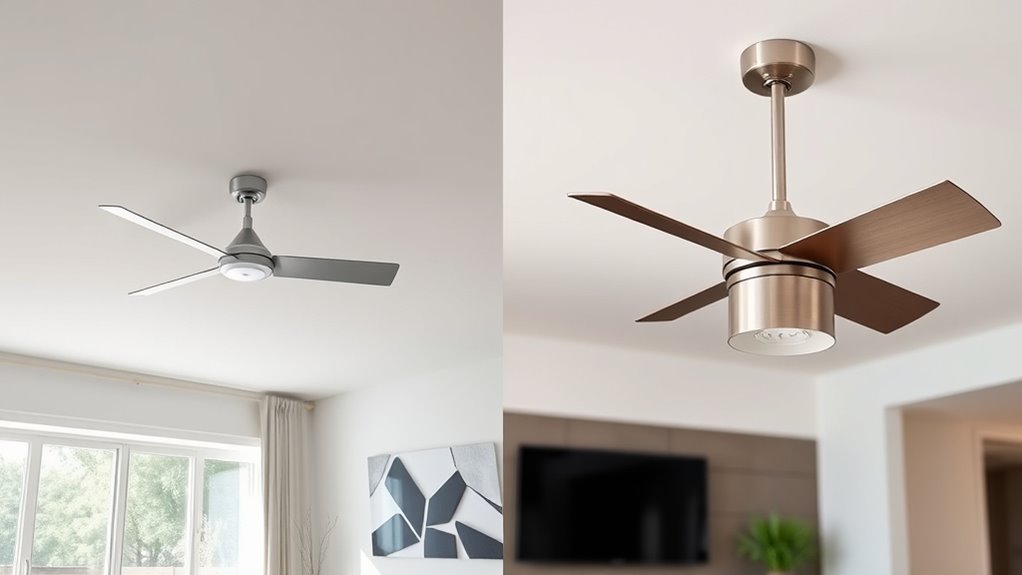
Your choice between flush-mount and downrod fans directly impacts airflow distribution and ventilation efficiency. You’ll notice how the design influences how well air circulates across the room, affecting comfort. Understanding these patterns helps you select the fan that delivers ideal ventilation for your space.
Airflow Distribution Patterns
When comparing flush-mount and downrod ceiling fans, understanding their airflow distribution patterns is essential for optimizing air circulation and ventilation efficiency. Your choice influences how air moves across the room, affecting comfort and energy use. Ceiling fan dynamics determine whether airflow circulates in a broad, gentle breeze or a more focused stream. Effective airflow patterns assure even air distribution without creating drafts or dead zones. The key differences include:
- Vertical airflow reach varies, with downrod fans dispersing air deeper into the room. Additionally, the blade pitch and size directly influence how effectively air is moved throughout the space.
- Air circulation zones differ, affecting how well air mixes.
- Blade pitch and size influence airflow patterns and overall efficiency.
- Fan height impacts how air is distributed, especially in rooms with high or low ceilings.
- Incorporating AI-driven analysis can optimize fan placement and operation for improved airflow and energy conservation.
Ventilation Effectiveness
Choosing the right ceiling fan impacts how effectively it circulates air and maintains comfortable temperatures throughout a room. A fan with good ventilation effectiveness improves air circulation, reducing hot spots and stale air. Downrod fans often provide better airflow coverage, enhancing ventilation efficiency, especially in larger rooms. Proper installation is essential for optimal performance; improper setup can reduce airflow and increase noise levels. Flush-mount fans are ideal for low ceilings but might have limited air movement, affecting overall circulation. Additionally, consider lighting options—many fans come with integrated lights that can improve room illumination. Energy efficiency is vital; select fans with high airflow per watt to save on electricity bills. Proper ventilation helps regulate temperature and humidity, making your space more comfortable. The design and placement of your fan also play crucial roles in maximizing airflow effectiveness. Ultimately, matching your fan’s installation style with your room’s size and features ensures optimal air circulation and ventilation effectiveness.
Ease of Installation and Maintenance
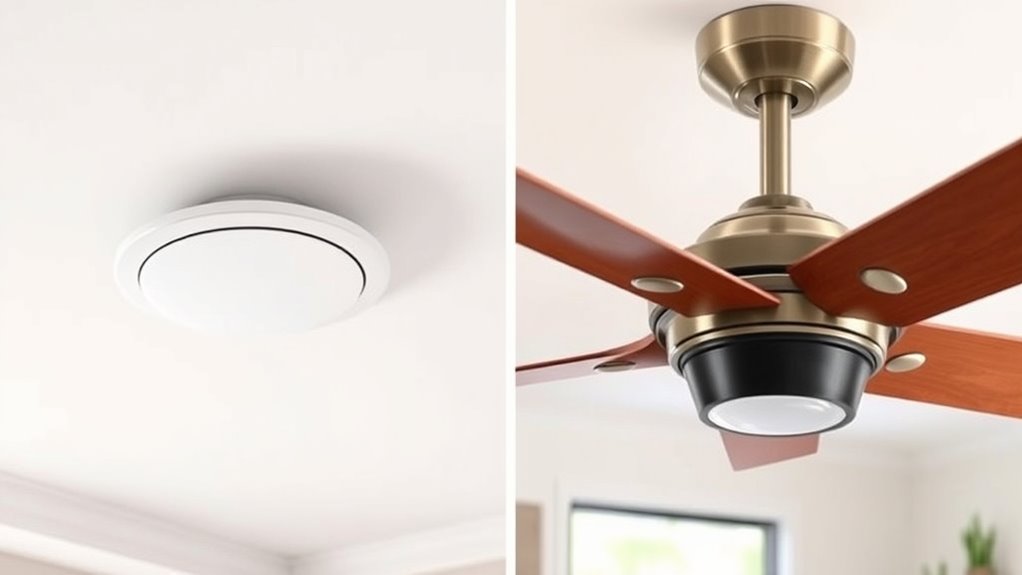
While both flush-mount and downrod ceiling fans are designed for straightforward installation, flush-mount fans typically offer a simpler setup since they attach directly to the ceiling without additional components. This makes them ideal if you want quick installation and easier maintenance. Flush-mount fans often have lower noise levels, contributing to a quieter environment, and their compact design can enhance energy savings by reducing air resistance. Additionally, their growth mindset allows for ongoing improvements in design and efficiency, making them a popular choice for many homeowners.
Flush-mount fans offer easy installation, quiet operation, and energy-efficient, space-saving design.
Consider these points:
- Fewer parts mean less maintenance and easier cleaning
- Simplified wiring reduces installation time
- Compact design minimizes dust accumulation
- Easy access for routine checks and repairs
Safety and Clearance Requirements
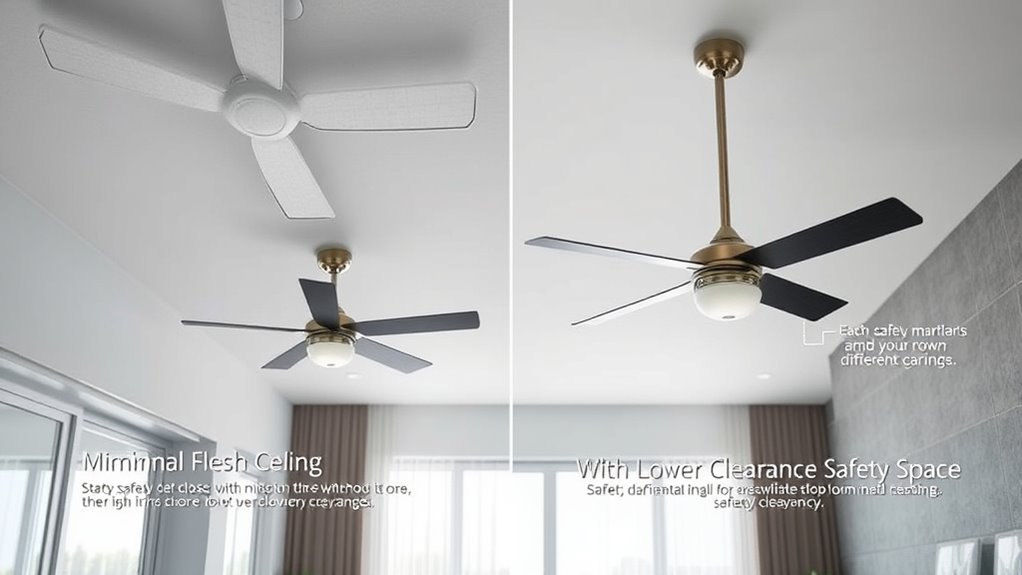
Safety and clearance requirements are critical considerations when selecting a ceiling fan, as improper installation can pose hazards or reduce performance. You need enough space around the fan to prevent accidents and ensure proper airflow. Flush-mount fans are ideal for low-ceiling rooms, providing a safe distance from the ceiling while accommodating lighting options that don’t hang down. Downrods allow for better clearance in taller spaces, but you must verify the minimum and maximum clearance distances to avoid hitting objects or people. Additionally, if you choose a fan with remote control features, ensure the remote receiver is properly installed and accessible without interference. Always follow manufacturer guidelines for safety and clearance to maximize performance and prevent potential hazards. Recognizing trust issues in your relationship can also help you address underlying problems that might affect your overall home environment and peace of mind.
Cost Implications and Value

The cost differences between flush-mount and downrod ceiling fans can substantially impact your overall budget and long-term value. Flush-mount fans are typically less expensive upfront and easier to install, saving you installation costs. Conversely, downrod fans may have higher initial prices but can offer better energy savings due to improved air circulation, especially in larger rooms. Noise levels are also a consideration, with some downrod models designed for quieter operation, adding to long-term comfort. To evaluate value, consider:
- Initial purchase and installation costs
- Long-term energy savings
- Noise levels and operational quietness
- Maintenance and durability over time
Balancing these factors helps ensure you choose an option that fits your budget while maximizing comfort and efficiency.
Making the Right Choice for Your Space

Choosing between flush-mount and downrod ceiling fans depends on your space’s size, ceiling height, and aesthetic preferences. If you have a low ceiling, a flush-mount fan offers a sleek look and saves space, while a downrod fan suits taller ceilings, providing better air circulation. Consider your lighting options—flush mounts often have integrated or close-to-ceiling lights, ideal for small or modern rooms, whereas downrod fans can support larger, more versatile lighting fixtures. Material durability matters too; look for fans made from sturdy materials that withstand humidity and daily wear. Ultimately, select a fan that complements your room’s size and style, offers reliable lighting, and is built to last, ensuring comfort and long-term value.
Frequently Asked Questions
Can Flush-Mount Fans Be Used Outdoors or in Wet Areas?
You can use flush-mount fans outdoors or in wet areas if they have outdoor durability and wet area suitability. Look for fans specifically rated for damp or wet locations, as these are designed to resist moisture, rust, and corrosion. Always check the manufacturer’s specifications to guarantee the fixture is safe for outdoor use. Properly rated flush-mount fans will provide reliable performance while standing up to the elements.
How Does Ceiling Height Influence Noise Levels for Each Installation Type?
Imagine your ceiling height as a comedy stage—short ceilings make fans sound like squeaky mice, while tall ceilings turn them into roaring lions. With low ceilings, noise levels stay in check, especially with flush-mount fans that keep things quiet and cozy. But in rooms with high ceilings, downrod fans can create a gentle hum, preventing the fan from becoming the room’s main noise distraction.
Are There Specific Lighting Options Compatible With Flush-Mount Fans?
When choosing ceiling fans, you’ll find many styles offer lighting compatibility, making them versatile for your space. Flush-mount fans often feature integrated or compatible lighting options that suit low ceilings, while some styles allow you to add or upgrade lighting as needed. Check the fan’s specifications to verify it matches your desired lighting setup, and pick from various styles to complement your room’s decor and meet your lighting needs seamlessly.
What Are Common Troubleshooting Tips for Downrod Fan Installations?
Did you know improper installation causes 80% of downrod fan issues? When troubleshooting, check fan blade alignment to prevent wobbling and ensure smooth operation. Also, inspect mounting bracket issues, as loose or misaligned brackets can cause instability. Tighten any loose screws and verify the downrod is securely attached. Regularly cleaning and balancing your fan helps maintain proper function, preventing common problems and extending its lifespan.
How Do Energy Efficiency and Power Consumption Compare Between the Two Types?
When comparing energy consumption and efficiency, flush-mount fans often use slightly less power because they’re smaller and designed for compact spaces, providing adequate airflow without overworking. Downrod fans, with their larger blades and higher speeds, may consume more energy but can move air more effectively in bigger rooms. Overall, the efficiency comparison depends on your room size and airflow needs, so choose a fan that balances power use and performance.
Conclusion
Choosing between flush-mount and downrod isn’t just about height—it’s about your room’s heartbeat. Think of your space as a canvas; the right fan style is the brushstroke that brings harmony and balance. Trust your instincts and consider your needs, then let your decision be the guiding star. When you pick the perfect mount, you’re not just installing a fan—you’re setting the tone for comfort, style, and airflow that truly resonates with your home’s soul.
